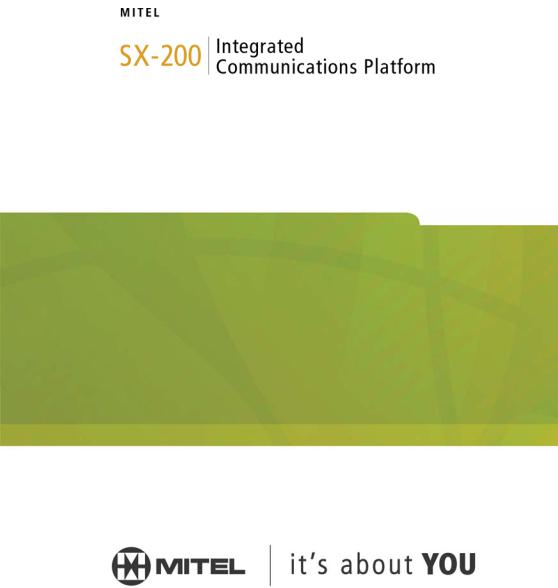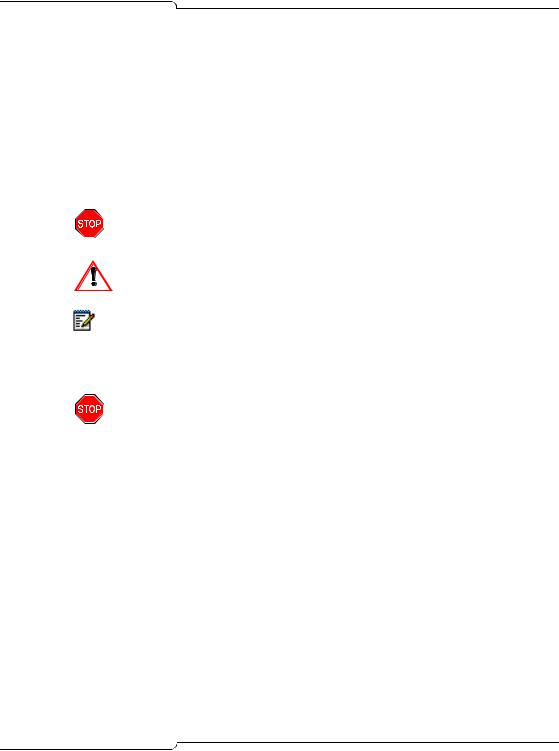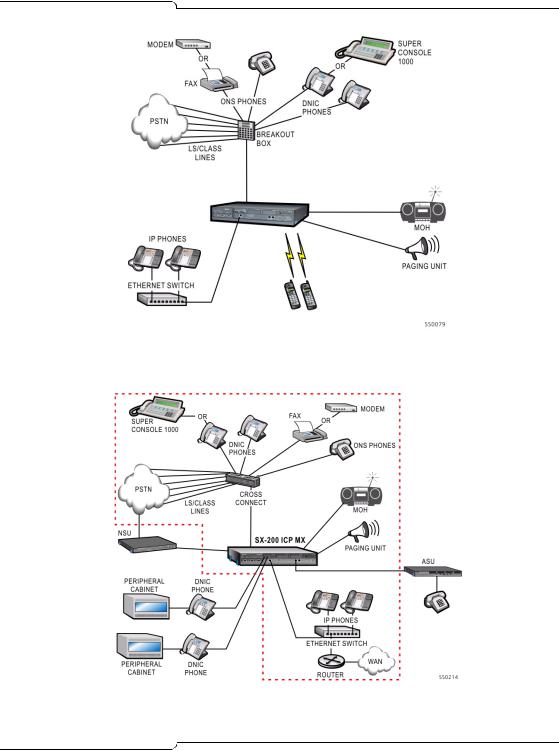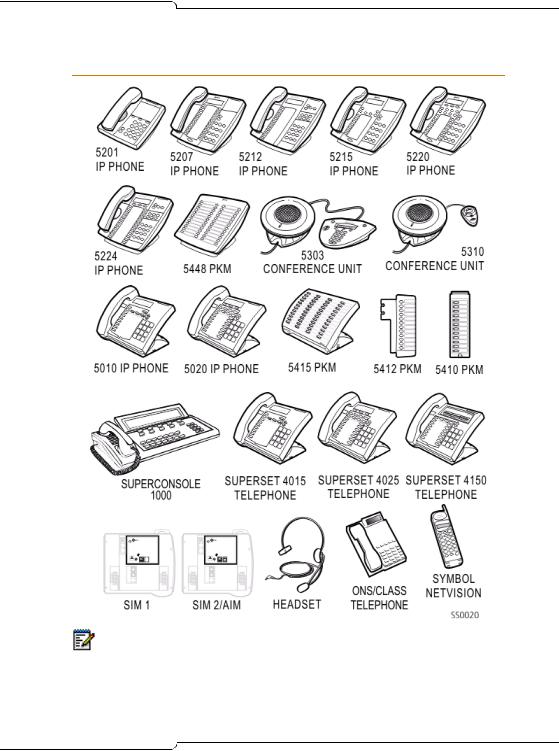Mitel sx-200 User Manual

MX Controller
TECHNICIAN’S HANDBOOK
Release 3.1

SX-200 ICP MX Technician’s Handbook
NOTICE
The information contained in this document is believed to be accurate in all respects but is not warranted by Mitel Networks™ Corporation (MITEL®). The information is subject to change without notice and should not be construed in any way as a commitment by Mitel or any of its affiliates or subsidiaries. Mitel and its affiliates and subsidiaries assume no responsibility for any errors or omissions in this document. Revisions of this document or new editions of it may be issued to incorporate such changes.
No part of this document can be reproduced or transmitted in any form or by any means - electronic or mechanical - for any purpose without written permission from Mitel Networks Corporation.
MITEL, SX-200, SUPERSET, SUPERCONSOLE 1000, MiTAI, MiLINK, and LIGHTWARE are trademarks of Mitel Networks Corporation.
Microsoft Windows is a registered trademark of Microsoft Corporation.
SpectraLink NetLink e340, h340, 640 Wireless Telephones are trademarks of Spectralink Corporation.
HYPERTERMINAL is a trademark of Hilgraeve Inc. VT100 is a trademarks of Digital Equipment Corporation.
All other product names specified in this document are trademarks of their corresponding owners.
SX-200 ICP MX Technician’s Handbook
51009229, Revision B
Release 3.1
February 2006
® ™Trademark of Mitel Networks Corporation
©Copyright 2006, Mitel Networks Corporation
All rights reserved
ii

Table of Contents
Chapter 1 : Introduction |
|
About this Handbook ............................................................................................ |
3 |
Purpose of this handbook ................................................................................ |
3 |
Who this handbook is written for ...................................................................... |
3 |
Where you can find more information .............................................................. |
4 |
Contacting Mitel® ............................................................................................. |
6 |
Symbols used in this handbook ....................................................................... |
7 |
Important safety instructions ............................................................................ |
7 |
About the SX-200® ICP MX .................................................................................. |
8 |
SX-200 ICP System Packages ........................................................................ |
8 |
System configurations...................................................................................... |
9 |
DSP Configuration Options ............................................................................ |
12 |
Cabinet Configuration Rules .......................................................................... |
14 |
Supported Peripherals ........................................................................................ |
15 |
Default Database Configuration .......................................................................... |
16 |
Telephone related .......................................................................................... |
16 |
Voice mail related........................................................................................... |
17 |
Trunk related.................................................................................................. |
17 |
System related ............................................................................................... |
17 |
Chapter 2 : Basic Installation |
|
Before you begin ................................................................................................. |
21 |
Quick Installation ................................................................................................ |
22 |
SX-200 ICP MX Hardware .................................................................................. |
24 |
Hardware ports and connectors ..................................................................... |
24 |
Controller components ................................................................................... |
25 |
Identify the required components................................................................... |
26 |
Installation checklist ....................................................................................... |
27 |
Installation overview ............................................................................................ |
30 |
Installing the SX-200 ICP MX Controller ............................................................. |
31 |
Install an Ethernet Switch ................................................................................... |
32 |
Small installations (under 20 phones) ............................................................ |
32 |
Larger installations (over 20 phones)............................................................. |
33 |
Feeding Power to IP Phones .............................................................................. |
34 |
Installing Software Using an External CompactFlash Card |
|
(Optional Initial Install) ........................................................................................ |
35 |
Installing Optional Controller Hardware .............................................................. |
37 |
Precautions .................................................................................................... |
37 |
Removing the cover ....................................................................................... |
38 |
iii

SX-200 ICP MX Technician’s Handbook
Install the Analog Option Board (AOB).......................................................... |
39 |
Installing Optional DSP Module(s)................................................................. |
41 |
Installing the Optional Dual FIM Module........................................................ |
43 |
Installing the Optional Quad CIM Module(s).................................................. |
44 |
Installing the Optional Dual T1/E1 Framer Module(s).................................... |
45 |
Installing a hard drive .................................................................................... |
46 |
Installing the Stratum Clock........................................................................... |
48 |
Wall or Rack Mounting ....................................................................................... |
49 |
Wall mounting the controller .......................................................................... |
49 |
Rack mounting the controller or NSU ............................................................ |
53 |
Installing an NSU ................................................................................................ |
54 |
Installing SX-200 Peripheral Cabinets ................................................................ |
57 |
FIM Connectivity............................................................................................ |
57 |
CIM Connectivity............................................................................................ |
57 |
Cabinet installation and programming ........................................................... |
58 |
Peripheral Cabinet Interface Cards and Modules.......................................... |
59 |
Peripheral Cabinet Control and Digital Services Cards and Modules ........... |
61 |
Peripheral Cabinet Configuration Rules ........................................................ |
62 |
Installing an ASU ................................................................................................ |
64 |
Connecting the Phones and Trunks ................................................................... |
66 |
ONS/CLASS, DNIC and LS/CLASS ports ..................................................... |
66 |
IP Phones ...................................................................................................... |
67 |
Adding a PKM .................................................................................................... |
68 |
Requirements ................................................................................................ |
68 |
CDE programming......................................................................................... |
69 |
Installation ..................................................................................................... |
69 |
PKM to an Attendant Console ....................................................................... |
71 |
Connecting Music on Hold, Paging and Door Phone/Door Opener ................... |
72 |
Music-on-Hold (MOH) interface..................................................................... |
72 |
Paging ........................................................................................................... |
72 |
Door Phone/Door Opener.............................................................................. |
73 |
Connecting a Night Bell and Alarm Device ........................................................ |
74 |
CDE programming for a Night Bell ................................................................ |
74 |
CDE programming for an Alarm Device ........................................................ |
74 |
Setting up an FTP Server on a Maintenance PC ............................................... |
75 |
CDE Programming......................................................................................... |
75 |
System Health Check ......................................................................................... |
77 |
iv

Table of Contents
Chapter 3 : Basic Programming |
|
Programming Overview ...................................................................................... |
81 |
Preparing to Enter Customer Data ...................................................................... |
82 |
PC requirements ............................................................................................ |
82 |
Serial Connection to the Controller ................................................................ |
82 |
Secure Telnet Connection to the controller.................................................... |
83 |
Web Interface Connection to the Controller ................................................... |
84 |
Port Usage ..................................................................................................... |
85 |
Enabling MOSS Options ..................................................................................... |
86 |
System Options to Avoid ..................................................................................... |
87 |
Programming the Customer Data Entry (CDE) Forms ........................................ |
87 |
Programming Features for each Phone .............................................................. |
88 |
Before you begin............................................................................................ |
88 |
Programming Embedded Voice Mail .................................................................. |
93 |
CDE Programming for Embedded Voice Mail................................................ |
93 |
Voice mail forms............................................................................................. |
94 |
Setting up RADs............................................................................................. |
96 |
Setting up Record a Call ................................................................................ |
97 |
Using the Administrator’s Mailbox.................................................................. |
99 |
Testing voice mail operation ........................................................................ |
102 |
Programming Phonebook ................................................................................. |
103 |
Programming an Attendant Console ................................................................. |
104 |
Programming a Subattendant Set ..................................................................... |
104 |
Programming a Printer Port .............................................................................. |
105 |
System Printer Port ...................................................................................... |
105 |
Dataset Printer Port...................................................................................... |
105 |
IP Printer Port............................................................................................... |
106 |
Programming Stations/Sets Automatically ........................................................ |
107 |
Deleting a Device and All Dependent Resources ............................................. |
109 |
Deleting a range of devices and dependent resources................................ |
109 |
Programming a Single Line Voice Station ........................................................ |
110 |
Programming a Multi-Line Set .......................................................................... |
111 |
Programming an Analog Device to a SIM2 (DNIC Phones Only) ..................... |
112 |
Programming an NSU or a PRI Card in a Peripheral Cabinet .......................... |
112 |
CDE programming ....................................................................................... |
112 |
IMAT Programming ...................................................................................... |
117 |
Programming an Embedded PRI Trunk ............................................................ |
125 |
Programming an Embedded T1 Trunk .............................................................. |
130 |
v

SX-200 ICP MX Technician’s Handbook
Programming Analog Trunks ............................................................................ |
131 |
Non Dial-In trunks........................................................................................ |
131 |
Dial-in trunks................................................................................................ |
133 |
DISA trunks ................................................................................................. |
134 |
Programming T1 and PRI trunks as DISA trunks ........................................ |
135 |
Programming ANI/DNIS on an Incoming trunk ............................................ |
135 |
CLASS trunks .............................................................................................. |
139 |
Running the Line Quality Test for LS Trunks............................................... |
140 |
Programming Symbol MiNET Wireless Phones (Optional) .............................. |
141 |
Install Symbol NetVision MiNET Phone Administrator Tool ........................ |
141 |
Twinning the Symbol phone with a wireline (desk) phone........................... |
142 |
Programming IP Sockets for Hotel/ Motel terminals and ACD Monitor ............ |
143 |
Programming Voice mail and PMS Integration ................................................ |
145 |
Requirements .............................................................................................. |
145 |
SX-200 ICP programming............................................................................ |
146 |
Setting up the Ether232............................................................................... |
146 |
Programming the PMS Interface on the SX-200 ICP ....................................... |
147 |
Requirements .............................................................................................. |
147 |
SX-200 ICP programming............................................................................ |
147 |
Programming for the 6010 Teleworker Solution ............................................... |
151 |
Requirements .............................................................................................. |
151 |
Installation and programming ...................................................................... |
151 |
Testing IP Phone connectivity and voice quality.......................................... |
152 |
Programming SpectraLink Wireless Telephones ............................................. |
153 |
Requirements .............................................................................................. |
153 |
Programming ............................................................................................... |
153 |
Programming with MyAdministrator ................................................................. |
158 |
Requirements .............................................................................................. |
158 |
Programming Call Forwarding - External ......................................................... |
159 |
Feature Limitations ........................................................................................... |
160 |
CDE Cross Reference ...................................................................................... |
164 |
Chapter 4 : Advanced Installation and Programming |
|
Overview .......................................................................................................... |
169 |
Planning your Installation ................................................................................. |
170 |
Basic PC Networking ........................................................................................ |
171 |
Enabling the (2nd) Port on IP Phones ......................................................... |
171 |
Virtual LANs (VLANs) ....................................................................................... |
172 |
Configuration 1: One DHCP server per VLAN............................................. |
172 |
vi

Table of Contents
Configuration 2: One external DHCP server for two VLANs ........................ |
175 |
Configuration 3: Router on a Stick ............................................................... |
177 |
Programming the controller IP address and DHCP settings ........................ |
178 |
Configuring a Windows 2000 DHCP server ................................................. |
178 |
Networking Mitel IP-PBXs ................................................................................. |
181 |
SX-200 ICP Programming............................................................................ |
182 |
Uniform Numbering Plan.............................................................................. |
184 |
Programming Unified Messaging ..................................................................... |
185 |
Requirements............................................................................................... |
185 |
Programming SMTP..................................................................................... |
185 |
Programming IMAP (Standard Unified Messaging) ..................................... |
188 |
Chapter 5 : Routine Maintenance |
|
Is the System Healthy? ..................................................................................... |
193 |
System health checklist................................................................................ |
193 |
Checking the System ........................................................................................ |
194 |
Installing FRUs .................................................................................................. |
195 |
Precautions .................................................................................................. |
195 |
Power Down System.................................................................................... |
196 |
Power Up System ........................................................................................ |
196 |
System Reset............................................................................................... |
197 |
System Shutdown ........................................................................................ |
197 |
Re-initializing the Controller ......................................................................... |
198 |
Replacing the Hard Drive or CompactFlash ..................................................... |
199 |
Replacing the Analog Main Board................................................................ |
200 |
Other FRUs .................................................................................................. |
202 |
Performing Backups .......................................................................................... |
203 |
Backing Up a Database ............................................................................... |
203 |
Restoring a Database .................................................................................. |
204 |
Installing an Alternate Database .................................................................. |
205 |
Upgrading the System Software ....................................................................... |
206 |
Upgrading from Release 1.x to Release 2.0 or later .................................... |
206 |
Upgrading from the External CompactFlash Card (Release 2.0 or later) .... |
207 |
Upgrading by FTP ........................................................................................ |
209 |
Upgrading the NSU or PRI Card Software ........................................................ |
210 |
Migrating an SX-200 EL/ML to an SX-200 ICP MX .......................................... |
211 |
Parts Required ............................................................................................. |
212 |
Preparations................................................................................................. |
212 |
Migration Procedure..................................................................................... |
212 |
vii

SX-200 ICP MX Technician’s Handbook |
|
Replacing IP Phones ........................................................................................ |
215 |
Restarting IP Phones ....................................................................................... |
216 |
Upgrading Set Firmware .................................................................................. |
216 |
Boot Codes.................................................................................................. |
217 |
Firmware Revision Levels............................................................................ |
217 |
Firmware Commands .................................................................................. |
217 |
Measuring LS Trunks ....................................................................................... |
218 |
Running the Line Quality Test ..................................................................... |
219 |
Running the Distortion Test ......................................................................... |
220 |
Running the Echo Test ................................................................................ |
220 |
Maintenance Commands ................................................................................. |
221 |
Maintenance Port Characteristics................................................................ |
221 |
Telnet Requirements ................................................................................... |
221 |
Entering Command Sequences................................................................... |
221 |
Logging In.................................................................................................... |
222 |
Logging Out ................................................................................................. |
222 |
Switching between Maintenance and CDE.................................................. |
223 |
Displaying the Card Configuration............................................................... |
223 |
Showing the System Identity ....................................................................... |
223 |
System Commands ..................................................................................... |
223 |
Report Commands....................................................................................... |
227 |
Traffic Measurement Commands ................................................................ |
229 |
Log Commands ........................................................................................... |
230 |
Diagnostic Function Commands.................................................................. |
231 |
Backing up Log and Trap Files using Kermit .................................................... |
232 |
Sending Logs and other System Files to an E-mail Address or FTP Server..... |
233 |
Retrieving Logs and other System Files using Kermit ...................................... |
234 |
Maintenance Tips ............................................................................................. |
234 |
Chapter 6 : Basic Troubleshooting and Repair |
|
About this Chapter ............................................................................................ |
237 |
Troubleshooting Tools ...................................................................................... |
238 |
Before you Contact Technical Support ............................................................. |
239 |
General Troubleshooting Steps ........................................................................ |
240 |
Using the Phone Debug Option................................................................... |
240 |
Checking the System LEDs .............................................................................. |
241 |
Controller LEDs ........................................................................................... |
241 |
NSU LEDs ................................................................................................... |
243 |
ASU LEDs ................................................................................................... |
245 |
Troubleshooting Phones and Peripherals Problems ........................................ |
246 |
NSU/PRI Troubleshooting ................................................................................ |
249 |
viii |
|

Table of Contents
PRI Debug Commands ................................................................................ |
250 |
Troubleshooting Analog Trunks ........................................................................ |
251 |
Basic Troubleshooting.................................................................................. |
251 |
Troubleshooting Signaling Problems ........................................................... |
252 |
Troubleshooting T1 Trunks (D4 DS-1) .............................................................. |
263 |
Synchronization............................................................................................ |
263 |
Signaling Types............................................................................................ |
264 |
Test/Verify (T1) ............................................................................................ |
264 |
Troubleshooting Voice Mail ............................................................................... |
268 |
SX-200 ICP Property Management System Interface ...................................... |
270 |
Property Management System Messages ................................................... |
270 |
SX-200 ICP and PMS Cannot Communicate............................................... |
273 |
Testing the PMS Interface of the PBX ......................................................... |
273 |
Chapter 7 : Advanced Troubleshooting and Repair |
|
About this Chapter ............................................................................................ |
277 |
General Network Troubleshooting .................................................................... |
278 |
Check List .................................................................................................... |
278 |
Troubleshooting IP Phone Connectivity ............................................................ |
280 |
Using a network analyzer to debug.............................................................. |
280 |
Connectivity problems.................................................................................. |
280 |
Troubleshooting IP Phone Registration ....................................................... |
281 |
IP Phone Analyzer ....................................................................................... |
289 |
Troubleshooting Phone Audio Quality .............................................................. |
291 |
Troubleshooting IP Trunks ................................................................................ |
294 |
CDE Check List............................................................................................ |
294 |
IP Check List................................................................................................ |
296 |
Appendix A : Default Database Values |
|
Default Database .............................................................................................. |
299 |
Default Database Values ............................................................................. |
301 |
Appendix B : Part Numbers...................................................................... |
351 |
Appendix C : System Cabling.................................................................. |
365 |
Appendix D : Phones and Features......................................................... |
377 |
Appendix E : Handling Fiber Optic Cables |
|
Guidelines for Handling Fiber Optic Cable ........................................................ |
395 |
Specifications ............................................................................................... |
395 |
Operation ..................................................................................................... |
396 |
ix

SX-200 ICP MX Technician’s Handbook
Appendix F : Folio Views (E-Docs) Tips |
|
About Folio Views ....................................................................................... |
399 |
Index |
|
x

Chapter 1
Introduction

SX-200 ICP MX Technician’s Handbook
2

Introduction
About this Handbook
Purpose of this handbook
This handbook provides
•an overview of the system capabilities
•installation steps
•programming procedures
•maintenance procedures
•troubleshooting information
Who this handbook is written for
This handbook is for a qualified technician who has successfully completed the SX-200® ICP Installation and Maintenance Course. The course has two parts: basic and advanced.
SX-200 ICP Basic Installation and Maintenance Course
You need to take the Basic I & M course if you are installing the SX-200 ICP as a voice system only.
This means that you are using the default settings for IP and you are not planning on implementing Virtual LANs (VLANs).
The basic course is available in self-study format and you must have completed your LIGHTWARE™ 19 RELEASE 3.2 certification.
SX-200 ICP Advanced Installation and Maintenance Course
You MUST complete the Advanced I & M course if you are planning to
•connect a PC to the PC port on the IP Phones (enable System Option 131)
•connect the SX-200 ICP in an existing LAN (Local Area Network)
•use an external DHCP (Dynamic Host Configuration Protocol) server
•implement VLANs (Virtual LANs)
•implement IP (Internet Protocol) Trunking
•network to a 3300 ICP via IP trunk or QSIG
The advanced course is available in a leader-led format. You must complete the Basic I & M course before attending the advanced course.
3

SX-200 ICP MX Technician’s Handbook
Where you can find more information
The SX-200 ICP documentation set includes the following components:
•Printed documents
-Technician’s Handbook
-Safety Instructions
•Documents supplied on the SX-200 ICP software CD-ROM
-SX-200 ICP Technical Documentation in Folio (NFO) format.
-Technician’s Handbook
-Safety Instructions
-IMAT Online Help (installs with IMAT application)
-MyAdministrator Online Help (installs with MyAdministrator application)
-Symbol® Netvision® MiNET Phone Installation Instructions (located in the Documentation folder on the SX-200 ICP software CD-ROM)
-Telephone, Attendant, Subattendant, Voice Mail, Hotel/Motel Front Desk, and MyAdministrator User Guides
-Technical Bulletins (TBs) and Release Notes (RNs).
Accessing Documentation on the software CD-ROM
1.Insert the CD in the CD-ROM drive.
2.Navigate to the Documentation folder.
3.Double-click Setup.exe to install the Technical Documentation and Folio Viewer, the application used to view the documentation.
4.To access user guides and other documentation, go to the appropriate Language subdirectory. Use the index.html file to locate the required guides.
Technical Training Materials
-SX-200 ICP Basic I & M Course Release 3.0
-SX-200 ICP Advanced I & M Course
4

Introduction
Release Notes
Every software release is accompanied by Release Notes, which describe software changes, bug fixes, outstanding issues, and hardware compatibility considerations for the new software release. Read the
Release Notes before you begin a software upgrade.
Technical Bulletins
Technical Bulletins (TBs) are issued by Mitel® Technical Support to address frequently asked questions regarding software and hardware problems. Obtain the latest TBs from Mitel OnLine.
Mitel Knowledge Base
The Mitel Knowledge Base is a searchable database of problem-solving information on the SX-200 ICP and other Mitel products. The database is accessed through Mitel Online.
Accessing Mitel Online
You can access Mitel Online from the www.mitel.com Web site.
Tip: You must be a registered user to access Mitel Online.
Access Product and Technical Documentation
1.Login to Mitel OnLine.
2.Navigate to Product Documentation (Technical Documents, User Guides, and Installation Guides) OR Knowledge Base (Release Notes and Technical Bulletins).
View or Download a Document
To view a document:
•Click on the name of the document. To download a document:
•Right-click on the name of the document and select Save Target As OR
•When viewing a PDF document, click the disk icon.
5

SX-200 ICP MX Technician’s Handbook
Create Telephone User Guides with Manual Maker
1.Login to Mitel OnLine.
2.Navigate to Product Documentation.
3.Click Manual Maker.
4.Follow the instructions on the screen to register and use Manual Maker.
Accessing Your Mitel Options Password
You must obtain your Mitel Options Password through Mitel Online (www.mitel.com). This password is required during the upgrade procedure, so you MUST keep a proper record of it. A new password is issued to you if you are purchasing new options. Before attempting the software upgrade, to confirm a current password or to purchase new options and receive a new password, call Mitel Customer Service during normal business hours.
Helpful websites
For definitions of technical terms
•http://www.techweb.com/encyclopedia
•http://www.whatis.com
For networking information
•http://www.practicallynetworked.com
•http://www.networktroubleshooting.com
Contacting Mitel
Sending Feedback
If you have suggestions on how to improve this documentation, please contact us at techpubs@mitel.com.
Order Desk
You can reach the Order Desk at 1-800-796-4835.
Repair Department
You must get a Return of Merchandise Authorization (RMA) form from the Repairs Department before sending equipment back to Mitel Network Corp.
You can reach the Repairs Department at 1-888-222-6483.
6

Introduction
Technical Support - Mitel Dealers
Please contact Mitel Technical Support if you require technical assistance.
If you cannot resolve the problem by using the Troubleshooting chapter, please collect the required information listed in “Before You Contact Technical Support” on page 91 before calling Mitel Technical Support. You can reach Technical Support at 1-800-561-0860 or 1-613-592-2122.
Symbols used in this handbook
Indicates a hazardous situation which, if not avoided, could result in injury or death.
Indicates a situation which, if not avoided, could result in damage to the equipment.
Identifies an important note or a useful tip.
Important safety instructions
Failure to follow all instructions may result in improper equipment operation and/or risk of electrical shock.
See the system Safety Instructions that are shipped with the system for complete safety information.
7

SX-200 ICP MX Technician’s Handbook
About the SX-200 ICP MX
The Mitel SX-200 Integrated Communications Platform (ICP) provides the reliability and comprehensive features of a PBX, the ease of use and cost effectiveness of a key system, and the productivity-enhancing applications and networking efficiency of IP.
Tailored for small enterprises, the SX-200 ICP MX supports up to 248 IP phones, 12 LS/CLASS circuits, and 24 IP trunks for private networking.
SX-200 ICP System Packages
The SX-200 ICP MX controller is sold alone or as a package that includes the components shown in the table below. None of the packages include power supplies for the phones; they must be ordered separately. For part numbers, see Appendix B.
Table 1: SX-200 ICP MX System Packages
|
|
Basic Business - |
Premier Business |
|
Basic |
||
|
|
Voice Only |
- Voice & Data |
Controller |
|||
|
|
|
|
|
|
|
|
|
LS/CLASS circuits |
|
6 |
|
|
|
|
|
|
|
|
|
|
|
|
|
ONS circuits |
|
2 |
|
|
|
|
|
|
|
|
|
|
|
|
|
DNIC circuits |
|
2 |
|
|
|
|
|
|
|
|
|
|
|
|
|
Voice mail ports |
|
4 |
|
|
|
|
|
|
|
|
|
|
||
|
DSPs |
|
1 Dual DSP Module |
|
|
||
|
|
|
|
|
|
||
|
IP Phones |
Seven 5207s |
Four 5220s |
|
|
||
|
|
One 5220 |
|
|
|
|
|
|
|
|
|
|
|
||
|
PKMs |
One 12-Button PKM |
|
|
|||
|
|
|
|
|
|
|
|
|
Licenses |
|
|
|
|
|
|
|
IP Phone |
16 |
8 |
|
|
|
|
|
Voice Mailbox |
16 |
8 |
|
|
|
None |
|
TDM |
44 |
32 |
|
|
|
|
|
|
|
|
|
|||
|
ACD Agent |
None |
5 |
|
|
|
|
|
IP Channel |
None |
2 |
|
|
|
|
|
|
|
|
|
|
||
|
Software Options |
1 Digital Link |
1 Digital Link |
|
|
||
|
|
Voice Mail Softkey |
Voice Mail Softkey |
|
|
||
|
|
|
2nd Port on IP Phones |
|
|
||
|
|
|
Record a Call |
|
|
||
|
|
|
|
|
|
|
|
|
|
|
|
|
|
|
|
|
|
|
|
|
|
|
|
8

Introduction
System configurations
The controller is configured at the factory as a square key telephone system (KTS). It can be reconfigured as a PBX or hybrid PBX/KTS by reprogramming the default database or by installing one of the alternate databases supplied on the software CD-ROM. For more information about alternate databases, see page 205. Both configurations are expandable through the purchase of additional components, including DSP resources (see “DSP Configuration Options” on page 12 for more information).
Table 2: SX-200 ICP System MX Configuration
Basic |
Expanded |
How Expanded |
|
|||
Configuration |
Configuration |
|
||||
|
|
|||||
|
|
|
|
|||
6 LS/CLASS circuits |
12 (Controller) |
Add Analog Options Card |
|
|||
(Controller) |
More than 12 |
Add Peripheral Bays (6 |
|
|||
|
|
|
|
|
max) |
|
|
|
|
|
|||
2 ONS/CLASS circuits |
4 (Controller) |
Add Analog Options Card |
|
|||
(Controller) |
More than 4 |
Add ASU (2 max) |
|
|||
|
|
|
|
|
Add Peripheral Bays (6 |
|
|
|
|
|
|
max) |
|
2 DNIC circuits |
More than 2 |
Add Peripheral Bays (6 |
|
|||
(Controller) |
|
max) |
|
|||
|
|
|
|
|||
0, 8, or 20 IP Phone |
248 IP Phone licenses |
Purchase additional |
|
|||
licenses depending on |
and 24 IP trunks |
licenses |
|
|||
system package |
|
Expand Ethernet Switch |
|
|||
0, 4, or 8 IP Phones |
Maximum 248 IP |
Purchase additional |
|
|||
depending on system |
|
licenses and phones |
|
|||
package |
|
|
|
|||
|
|
|
|
|||
0, 4, or 20 ports of voice |
24 ports |
Purchase Options and |
|
|||
mail depending on |
|
DSP resources |
|
|||
system package |
More than 24 |
(incremental) |
|
|||
|
|
|
|
|
Add standalone voice mail |
|
|
|
|
|
|
system or Peripheral Bays |
|
|
|
|
|
|
with Mitel Express |
|
|
|
|
|
|
Messenger card(s) |
|
0 or 4 voice mail user |
748 |
Purchase additional |
|
|||
licenses depending on |
|
licenses (incremental) |
|
|||
system package |
|
|
|
|||
|
|
|
|
|
|
|
|
|
|
|
|
(Page 1 of 2) |
|
|
|
|
|
|
|
|
|
|
|
|
|
|
|
|
|
|
|
|
|
|
9

SX-200 ICP MX Technician’s Handbook
Table 2: SX-200 ICP System MX Configuration (continued)
|
Basic |
Expanded |
How Expanded |
|||
|
Configuration |
Configuration |
||||
|
|
|
|
|
||
|
|
|
|
|
|
|
|
Approximately 5 hours of |
Depends on capacity of |
Install hard drive |
|||
|
voice mail message |
upgraded media |
|
|
|
|
|
storage |
|
|
|
|
|
|
Three 3-party |
21 3-party Conferences |
Purchase DSP resources. |
|||
|
conferences |
(total 21 conferees – |
|
|
|
|
|
|
can have up to 5 |
|
|
|
|
|
|
parties per conference) |
|
|
|
|
|
|
|
|
|||
|
256 MB of |
Larger capacity media |
Install hard drive |
|||
|
CompactFlash memory |
|
|
|
|
|
|
for database storage |
|
|
|
|
|
|
(inside controller) |
|
|
|
|
|
|
Dual DSP MMC |
2 dual DSP MMC or 1 |
Purchase modules |
|||
|
|
dual and 1 quad DSP |
|
|
|
|
|
|
MMC or 2 quad DSP |
|
|
|
|
|
|
MMC |
|
|
|
|
|
|
|
|
|||
|
0 Links PRI-T1 |
4 Links PRI-T1 |
Purchase 2 NSUs or 2 |
|||
|
|
|
Peripheral Bays with PRI |
|||
|
|
|
cards |
|||
|
|
|
|
|
|
(Page 2 of 2) |
|
|
|
|
|
|
|
|
|
|
|
|
|
|
|
|
|
|
|
|
|
10

Introduction
SX-200 ICP MX
WIRELESS
PHONES
Figure 1: Basic System
Figure 2: Expanded System
11

SX-200 ICP MX Technician’s Handbook
DSP Configuration Options
The SX-200 ICP MX has six DSP configurations selectable in CDE Form 04:
•Business Option 1
•Business Option 2
•Hospitality Option
•Analog Option 1, 2, and 3
The table below lists the DSP requirements for each of the DSP configuration options. The requirements are guidelines only; the actual number of DSPs required depends on the intended use of the system.
Table 3: DSP Configuration Options
|
|
Base Dual DSP |
2 Dual DSP or |
Add Quad DSP |
2 Quad DSP |
|||
|
Option Type |
1 Quad DSP |
(6 total) |
|||||
|
(2 total) |
|
(8 total) |
|||||
|
|
(4 total) |
|
|
|
|
||
|
|
|
|
|
|
|
|
|
|
Business |
3 conf x 3 |
8 conf x 3 |
12 conf x 3 |
|
12 conf x 3 |
||
|
Option 1 |
parties |
parties |
parties |
|
parties |
||
|
IP |
4 voice mail |
12 voice mail |
18 voice mail |
24 voice mail |
|||
|
(see Note) |
8 G.729 |
8 G.729 |
16 G.729 |
|
24 G.729 |
||
|
|
48 IP |
96 IP |
96 IP |
|
192 IP |
||
|
|
6 DNIC/ONS |
6 DNIC/ONS |
96 DNIC/ONS |
192 DNIC/ONS |
|||
|
|
12 LS/Class |
12 LS/Class |
12 LS/Class |
12 LS/CLASS |
|||
|
|
|
24 T1 or 23 PRI |
48 T1 or 46 PRI |
96 T1 or 92 PRI |
|||
|
|
|
|
|
|
|
||
|
Business |
8 conf x 3 |
12 conf x 3 |
18 conf x 3 |
|
21 conf x 3 |
||
|
Option 2 |
parties |
parties |
parties |
|
parties |
||
|
IP |
8 voice mail |
18 voice mail |
24 voice mail |
24 voice mail |
|||
|
|
0 G.729 |
0 G.729 |
8 G.729 |
|
16 G.729 |
||
|
|
48 IP |
96 IP |
96 IP |
|
192 IP |
||
|
|
6 DNIC/ONS |
6 DNIC/ONS |
96 DNIC/ONS |
288 DNIC/ONS |
|||
|
|
12 LS/CLASS |
12 LS/CLASS |
12 LS/CLASS |
12 LS/CLASS |
|||
|
|
|
24 T1 or 23 PRI |
48 T1 or 46 PRI |
96 T1 or 92 PRI |
|||
|
Hospitality |
8 conf x 3 |
8 conf x 3 |
12 conf x 3 |
|
12 conf x 3 |
||
|
Option |
parties |
parties |
parties |
|
parties |
||
|
IP+TDM |
8 voice mail |
12 voice mail |
18 voice mail |
24 voice mail |
|||
|
|
0 G.729 |
8 G.729 |
16 G.729 |
|
16 G.729 |
||
|
|
96 DNIC/ONS |
48 IP |
96 IP |
|
248 IP |
||
|
|
12 LS/CLASS |
96 DNIC/ONS |
192 DNIC/ONS |
384 DNIC/ONS |
|||
|
|
|
12 LS/CLASS |
12 LS/CLASS |
12 LS/CLASS |
|||
|
|
|
48 T1 or 46 PRI |
48 T1 or 46 PRI |
96 T1 or 92 PRI |
|||
|
|
|
|
|
|
|
||
|
Analog |
2 conf x 3 |
8 conf x 3 |
12 conf x 3 |
|
21 conf x 3 |
||
|
Option 1 |
parties |
parties |
parties |
|
parties |
||
|
|
6 voice mail |
18 voice mail |
24 voice mail |
24 voice mail |
|||
|
|
0 G.729 |
0 G.729 |
0 G.729 |
|
0 G.729 |
||
|
|
24 IP |
48 IP |
96 IP |
|
192 IP |
||
|
|
288 DNIC/ONS |
288 DNIC/ONS |
288 DNIC/ONS |
384 DNIC/ONS |
|||
|
|
12 LS/CLASS |
12 LS/CLASS |
12 LS/CLASS |
12 LS/CLASS |
|||
|
|
48 T1 or 76 PRI |
72 T1 or 69 PRI |
72 T1 or 69 PRI |
96 T1 or 92 PRI |
|||
|
|
|
|
|
|
|
|
(Page 1 of 2) |
|
|
|
|
|
|
|
|
|
|
|
|
|
|
|
|
|
|
12

Introduction
Table 3: DSP Configuration Options (continued)
|
Base Dual DSP |
2 Dual DSP or |
Add Quad DSP |
2 Quad DSP |
|
Option Type |
1 Quad DSP |
(6 total) |
|||
(2 total) |
(8 total) |
||||
|
(4 total) |
|
|||
|
|
|
|
||
Analog |
2 conf x 3 |
10 conf x 3 |
12 conf x 3 |
21 conf x 3 |
|
Option 2 |
parties |
parties |
parties |
parties |
|
|
4 voice mail |
12 voice mail |
16 voice mail |
24 voice mail |
|
|
0 G.729 |
0 G.729 |
0 G.729 |
0 G.729 |
|
|
24 IP |
48 IP |
48 IP |
96 IP |
|
|
384 DNIC/ONS |
384 DNIC/ONS |
480 DNIC/ONS |
480 DNIC/ONS |
|
|
12 LS/CLASS |
12 LS/CLASS |
12 LS/CLASS |
12 LS/CLASS |
|
|
48 T1 or 46 PRI |
48 T1 or 46 PRI |
48 T1 or 46 PRI |
48 T1 or 46 PRI |
|
Analog |
|
8 conf x 3 |
|
|
|
Option 3 |
|
parties |
|
|
|
(Requires |
|
12 voice mail |
|
|
|
Quad DSP) |
|
0 G.729 |
|
|
|
|
|
96 IP |
|
|
|
|
|
576 DNIC/ONS |
|
|
|
|
|
12 LS/CLASS |
|
|
|
|
|
96 T1 or 92 PRI |
|
|
|
|
|
|
|
(Page 2 of 2) |
|
|
|
|
|
|
 Notes:
Notes:
1.The number of conference, voice mail, and compression resources is fixed by the purchased option and the number of DSP devices available; the other values are adjustable.
2.The SX-200 ICP supports the G.711 and G.729a codecs.
-The G.711 PCM audio codec for 56/64 kbps generally provides the best voice quality and is comparable to TDMtype connections.
-The G.729a audio codec for 8/13 kbps provides a good reduction in bandwidth with only minor loss in voice quality.
-A purchasable MOSS option controls the number of G.729a codecs available to IP devices in the system. Compression enables more devices to share available bandwidth.
-The option is purchasable in multiples of 8 to a maximum of 24. The default value is 0. The quantity entered must exactly match the quantity on the MOSS sheet.
13

SX-200 ICP MX Technician’s Handbook
3.Installation of a hard drive is strongly advised for systems that have more than eight voice mail ports or when Record a Call is frequently used.
4.The MX controller can support 12 LS/CLASS, 2 DNIC, and 4 ONS on the internal analog boards in all option configurations.
5.All T1 trunk quantities include any combination of T1/D4 or T1/PRI.
6.The maximum system capacity is 672 TDM (ONS/DNIC) ports. In any option configuration, trunks may be added up to a maximum of 8 digital links (192 trunks) but only by reducing the number of digital bays (ONS and DNIC ports) connected, so that the total number of TDM ports does not exceed that shown in the table.
7.If System Option 82 is enabled (DSP Echo Cancellers), then one DSP device is removed from the available pool. The number of TDM resources (voice mail and conference) will be reduced. This option cannot be used in a base system with compression enabled (Business Option 1) or with a large number of TDM devices (Analog Options 1 and 2).
Cabinet Configuration Rules
The MX controller can be expanded to include:
•up to seven SX-200 Peripheral cabinets which provide 672 TDM ports for ONS, OPS, DID, T1, PRI/T1
•up to four Universal NSUs which provide eight PRI Links (192 PRI/T1 trunks)
•up to two offboard ASUs which provide 48 ONS/CLASS circuits
14

Introduction
Supported Peripherals
Note: The SX-200 ICP (R2.1 or later) also supports the Dual Mode (or DPLite) 5215 and 5220 IP phones. The Dual Mode phones look the same as the original 5215 and 5220 phones. Check the label on the underside of the phone to determine which type it is. The originals are identified as 5215 or 5220 “Dual Port.”
15

SX-200 ICP MX Technician’s Handbook
Default Database Configuration
The CDE Forms are factory-set with default values that make it easier and faster to program the system. The defaults allow you to install the SX-200 ICP in a square KTS (key telephone system) configuration with up to 20 IP phones and two analog terminals (phone, fax, or modem) and make extension-to-extension calls without doing any programming. You will also be able to receive fax and modem calls, but will have to program ARS to make external calls from ONS devices.
Two alternate databases are provided on the SX-200 ICP software CD: a blank database that has no programming and a Premier database for the SX-200 ICP Premier system. A database programmed with 4-digit extension numbers is also available on Mitel Online. See page 205 for more information about the alternate databases and how to install them.
The default database includes the following:
Telephone related
•3 digit extension numbers that start at extension 100
•IP phone extensions that start at extension 102
•Ports on the Controller
-6 LS CLASS
-2 ONS (extensions 201 and 202)
-2 DNIC (extension 198 is the SUPERCONSOLE 1000® and 199 is the sub attendant.)
•7 default classes of service (COS 1 – 7). They are for IP Phones, ONS, Subattendant, Attendant Console, LS/CLASS, Voice Mail, and IP trunks.
•default key programming on the sets for a 6-line square system
•default ring cadences
•all phones assigned to paging group 1
•the handsfree microphone is not automatically turned on when receiving a page (auto-latched).
16

Introduction
Voice mail related
•4 Voice mail ports (Business 1 Option with Dual DSP); 8 ports (Business 2 and Hospitality Options with Dual DSP)
•20 Voice mail mailboxes are assigned with the same extension numbers as the
-first 20 IP phones (extension 100 to 119)
-Attendant Console (SUPERCONSOLE 1000; extension 198)
-Subattendant (extension 199)
-2 ONS ports (extensions 200 and 201)
•Hunt Group for Voice mail ports with pilot number 300
-COS 6 and
-reserve extension 301 to 304 for voice mail port extensions
•system-wide Call Forward No Answer to voice mail for all calls.
Trunk related
•trunks in form 14 are non-dial-in to the CO line keys
•LS trunk circuit descriptor defaulted as CLASS
•one LS trunk programmed to Key 1 on IP Phones
•no ARS, no dial 9 for trunk access
System related
•default system options
•default feature access codes
•the default music port (located on the analog mainboard) is ON
•the default paging port (located on the analog mainboard) is ON
•the night bell extension is 340
•SMDR/CDE Print default to ON
•default DHCP settings and a SX-200 ICP Controller default IP address (192.168.1.2) to match (factory-set).
 Note: See Appendix A for a list of default values in the programming forms.
Note: See Appendix A for a list of default values in the programming forms.
17

SX-200 ICP MX Technician’s Handbook
18

Chapter 2
Basic Installation

SX-200 ICP MX Technician’s Handbook
20
